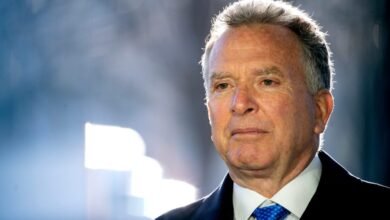
Unlock the White House Watch newsletter for free
Your guide to what the 2024 US election means for Washington and the world
Donald Trump’s tariffs have shocked global markets — and left the US Federal Reserve with a thorny problem: cut interest rates to help prevent a sharp economic slowdown, or keep them high to pre-empt a new burst of inflation.
The market bias is towards cuts. After the plunge across equity markets following the president announced his “liberation day” tariffs, traders are now betting that the Fed will reduce rates four or five times this year — up from three before Trump’s big reveal.
The message from Fed chair Jay Powell, however, was more hawkish for rates. The tariffs would have a “persistent” impact on US inflation, he said on Friday, which would make it harder for the central bank to begin easing.
It is a divergence that could partly define the US economy this year. Wall Street banks are already grappling with the problem as they revise up their targets for inflation this year, but trim back their predictions for growth — even warning the US could tumble into recession if Trump does not pull back from the brink on tariffs.
That implies action from the Fed to lower rates. Trump agrees.
Shortly before Powell spoke on Friday — and with the S&P in the throes of a brisk sell-off — the president said on Truth Social that it would be “a PERFECT time” for the chair to slash borrowing costs. “He is always ‘late,’ but he could now change his image, and quickly,” the president said. “CUT INTEREST RATES, JEROME, AND STOP PLAYING POLITICS!”
Many economists think the problem is less clear-cut. At 2.5 per cent, personal consumption expenditures inflation remains above the Fed’s 2 per cent goal — and officials expect the tariffs to quicken the pace again.
“The Fed is in an exceptionally difficult position right now,” said Sarah House, senior economist at Wells Fargo. She expected the central bank to keep rates at 4.25 per cent to 4.5 per cent “for as long as possible”.

Adriana Kugler, a Fed governor, said on Monday that keeping longer-term inflation expectations should be “a priority” and claimed that the front-loading of purchases of goods such as cars on the back of tariff announcements could boost growth in the short term.
BlackRock chief executive Larry Fink said on Monday he was also more concerned about inflation, saying he saw “zero chance” for cuts in the near term.
“I’m concerned about inflation if all the proposed tariffs truly go into place,” he said.
Fed officials have also signalled that until there are clear signs that this economic boost has gone into reverse and any effect of Trump’s trade shock on prices fades, the central bank will stay in “wait-and-see mode”.
Adam Posen, president of the Peterson Institute for International Economics think-tank, said the Fed would not “prejudge” the impact of the tariffs or Trump’s fiscal plans, such as deep tax cuts.
“Whether that’s going to work or not, that’s clearly the line that Powell and the Fed’s leadership have taken to navigate this political situation,” Posen said. The Fed “could and, arguably should, wait until September” before cutting rates, he added.
Markets think it will be much earlier, with a cut of either 0.25 or 0.5 percentage points at the Fed’s June meeting — an accelerated timetable compared with the quarter-point reduction in July that traders expected just last week.
Economists, though, say the central bank will prioritise price pressures above the recession risk — especially after its battle in the past two years to quell one of the worst inflation surges in living memory.
“In this environment, where there’s also this push to inflation, it’s unlikely [the Fed is] going to act preemptively and make insurance cuts,” said Claudia Sahm, a former Federal Reserve official who is now chief economist at New Century Advisors.
Oil prices are down, interest rates are down (the slow moving Fed should cut rates!), food prices are down, there is NO INFLATION, and the long time abused USA is bringing in Billions of Dollars a week from the abusing countries on Tariffs that are already in place. This is…
— Donald J. Trump (@realDonaldTrump) April 7, 2025
Vincent Reinhart, a former Fed official who is now chief economist at BNY Investments, said rate-setters could struggle to develop a clear strategy given the “especially uncertain” outlook.
The danger for the Fed of waiting for a “clear demonstration” of the tariff impact on the economy was that it might act too late, he added. “Waiting for as long as possible is tailor-made to waiting too long.”
Much depends first on Trump and how severe his tariffs are. On Monday, he proposed to ratchet up levies on the world’s biggest exporter, China, while also signalling his openness to trade deals with countries such as Japan.
If he sticks with the harshest tariffs, the impact on consumer demand could be severe enough to dispel any concerns about prices and put all the focus on the health of the economy.
“The balance of probabilities is that this doesn’t end up leading to inflation in the longer run,” said Krishna Guha, at Evercore ISI.
https://www.ft.com/__origami/service/image/v2/images/raw/https%3A%2F%2Fd1e00ek4ebabms.cloudfront.net%2Fproduction%2Ff4388a7d-3c23-4d1a-8b94-f1e323320272.jpg?source=next-article&fit=scale-down&quality=highest&width=700&dpr=1
2025-04-08 00:01:49





